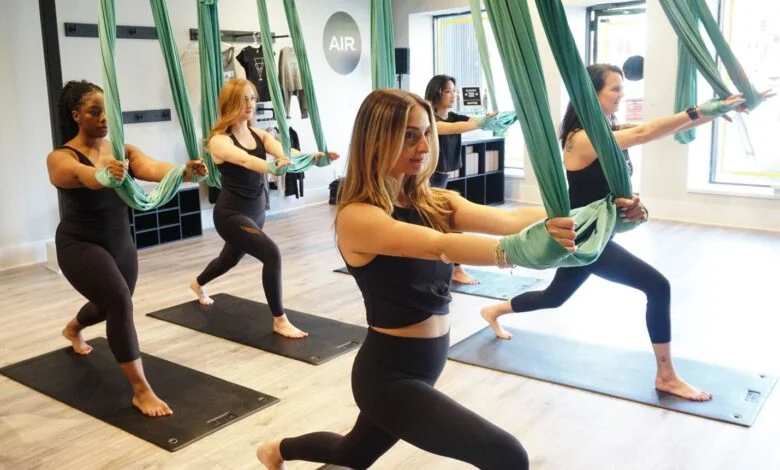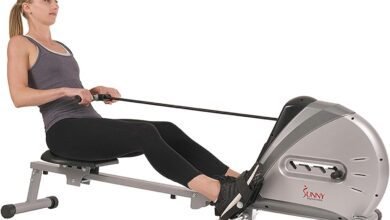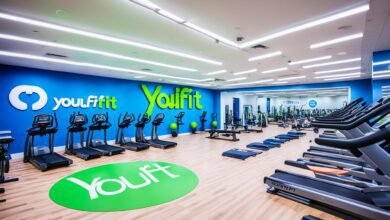Take Off High Examining the Universe of Aerial Fitness

In recent years the unique and thrilling training fad known as aerial fitness has seen a meteoric rise in popularity. An interesting and exceptional exercise is given by aerial fitness which consolidates parts of dance trapeze artistry and strength preparation. Let’s explore the advantages strategies and reasons for the global fascination with this dynamic kind of training among fitness aficionados.
How Do You Get Aerial Fitness?
Practicing different workout positions and motions while hung from aerial apparatus like silk hoops or hammocks is known as aerial fitness. Strength flexibility and coordination are required in providing a full-body exercise that works muscles that are sometimes ignored in conventional workouts.
The Equipment
Aerial Silks
Silks also known as aerial fabric or tissue consist of two long pieces of fabric suspended from a height. Members utilize the texture to perform climbs, wraps, and drops exhibiting tastefulness and strength while resisting gravity.
Aerial Hoop (Lyra)
The aerial hoop which looks like a suspended hula hoop lets you do dynamic moves inside and around the hoop as well as spins and poses.Its circular structure challenges participants to master fluid transitions and graceful poses.
Aerial hammock
The aerial hammock made areas of strength for of suspended in a circle upholds a great many developments from reversals to yoga-propelled presents offering both help and challenge for experts.
Advantages of Aerial Fitness
Aerial fitness engages multiple muscle groups simultaneously promoting overall strength flexibility and endurance. It targets core muscles while enhancing upper body and grip strength through aerial maneuvers.
Improved Flexibility and Balance
Regular practice enhances flexibility as participants perform stretches and poses in mid-air simultaneously improving balance and body awareness.
Mental Well-being
The focus required during aerial fitness sessions promotes mindfulness and reduces stress. The sense of achievement from mastering new moves boosts confidence and fosters a positive mindset.
Techniques and Safety
Aerial fitness requires proper technique and safety measures. Fledglings frequently start with essential moves and step by step progress to further developed moves under the direction of ensured educators. Security mats and spotting are ordinarily utilized during preparing to limit the gamble of injury.
Who Can Participate?
Aerial fitness is inclusive and adaptable for various fitness levels and ages. Modifications and progressions cater to individual abilities making it accessible to beginners while continually challenging experienced practitioners.

Aerial fitness requires upper body strength to begin
Upper body strength while advantageous isn’t a mandatory requirement to start aerial fitness. The magnificence of aeronautical fitness classes lies in their customized plan to oblige people with fluctuating fitness levels incorporating those with restricted chest area strength. These classes are organized to work with a slow and moderate improvement of solidarity particularly in the chest area through a progression of designated practices and concentrated strategies. They’re fastidiously created to draw in unambiguous muscle bunches in the arms, shoulders and center cultivating strength-working after some time. Individuals starting with minimal upper body strength shouldn’t feel discouraged. Instructors curate exercises that focus on foundational movements allowing participants to develop the necessary strength and technique at a pace suitable for them.
Aerial fitness safe
Aerial fitness when led under the cautious direction of qualified educators is viewed as a for the most part safe type of active work. These teachers assume a significant part in guaranteeing the security of members by executing severe wellbeing conventions and stressing legitimate strategies all through the classes. Qualified teachers go through thorough preparation to comprehend the complexities of aerial gear strategies and security measures. Their expertise enables them to create a secure environment for participants reducing the risk of injuries significantly.
Safety is paramount in aerial fitness classes. Instructors meticulously inspect and maintain the aerial equipment ensuring its stability and reliability before every session. They conduct thorough checks on rigging, silks, hoops or any apparatus used ensuring they’re securely installed and in optimal condition for use.
Age or weight limitations for aerial fitness
Aerial fitness is a flexible and comprehensive type of activity that can be adjusted to oblige people of different ages and body types. One of its strengths is its adaptability which enables people of varying physical abilities to participate and gain from the experience. Classes often welcome participants across a wide age spectrum from children to seniors showcasing the accessibility of aerial fitness. Children’s classes may emphasize foundational movements and safety measures suitable for their age group while adult classes might focus on more complex techniques and conditioning.
Similarly aerial fitness is adaptable for different body types. The exercises and techniques taught in these classes can be modified to suit the varying fitness levels strengths and flexibility of participants. Instructors tailor their guidance to accommodate individuals with different body compositions ensuring everyone can engage and progress at their own pace.
Aerial fitness helps with overcoming fear of heights
For individuals grappling with a fear of heights engaging in aerial fitness can serve as a gradual and empowering method to confront and potentially overcome this fear. Aerial fitness classes provide a supportive environment where participants navigate exercises and movements at varying heights offering a controlled setting to address and manage their fear. The classes are conducted at different elevations allowing individuals to start at lower heights and progressively work their way up as they become more comfortable and confident. This incremental approach aids participants in acclimating to heights in a controlled and safe environment.
Participants initially experience exercises closer to the ground gradually advancing to higher levels as they build trust in themselves the equipment and their instructors. This step-by-step progression fosters a sense of achievement and bolsters confidence empowering individuals to confront their fear of heights in a manageable and controlled setting.
Aerial fitness cause injuries
However this risk can be effectively managed and minimized through several crucial measures that prioritize safety and well-being.
Proper Instruction: Qualified instructors play a pivotal role in mitigating injury risks by providing comprehensive guidance on technique form and safety protocols. Their expertise ensures participants learn correct execution of movements reducing the likelihood of accidents due to improper posture or technique.
Equipment Checks: Prior to each session meticulous checks and maintenance of aerial equipment are conducted. This includes thorough inspections of rigging apparatus stability and overall equipment condition. Normal evaluations and upkeep schedules assist with guaranteeing that the hardware fulfills wellbeing guidelines altogether limiting the possibilities of gear related mishaps.
Continuous Movement: A critical part of injury counteraction in aerial fitness is the accentuation on continuous movement. Classes are intended to present activities and strategies in an organized way permitting members to steadily develop fortitude adaptability and abilities. This steady methodology limits the gamble of overexertion or strain due to endeavoring progressed developments rashly.
Security Rules Adherence: It is essential to strictly adhere to safety guidelines. Educators reliably support wellbeing conventions underlining the significance of warm-ups cool-downs and appropriate body arrangement during works out. Members are urged to adhere to somewhere safe guidelines tirelessly altogether decreasing the possibilities of wounds.
Support and spotting: Teachers frequently utilize spotting methods and use wellbeing mats or spotters to offer extra help during testing moves. This security net adds an additional layer of assurance particularly when members are learning new or more intricate developments.
Individual Mindfulness: Members are urged to keep up with individual mindfulness during classes paying attention to their bodies and recognizing any uneasiness or impediments. Being aware of one’s actual capacities and imparting worries to teachers forestalls possible wounds.
Explicit degree of adaptability expected for aerial fitness
While having a degree of adaptability can be invaluable it’s anything but a flat out essential for beginning aerial fitness. Aerial fitness classes are intended to oblige people with fluctuating degrees of adaptability guaranteeing that everybody can partake and advance. The act of aeronautical fitness intrinsically adds to the improvement of adaptability over the long run.As participants engage in aerial exercises and maneuvers the body gradually adapts to the movements and stretches involved naturally enhancing flexibility. Repetitive engagement in these exercises helps to increase the range of motion promoting flexibility gains in muscles and joints.
Instructors in aerial fitness classes recognize the importance of flexibility and incorporate specific exercises aimed at gradually enhancing participants’ flexibility. These exercises often focus on targeted muscle groups used in aerial movements such as the shoulders, back, hips and legs. Stretching routines both active and passive form an integral part of the classes aiding in lengthening and loosening tight muscles thus improving flexibility.
Aerial fitness helps with weight loss
Aerial fitness fills in as a viable and drawing in practice routine that can fundamentally add to weight reduction and backing by and large weight the executive’s objectives. This type of fitness draws in numerous muscle bunches all through the body making it a complete exercise that guides in consuming calories and upgrading cardiovascular wellbeing. The dynamic and diverse movements involved in aerial fitness sessions engage various muscle groups simultaneously. Exercises such as climbs, hangs, wraps and transitions require significant effort from muscles across the arms, core, legs and back. This comprehensive engagement results in increased calorie expenditure helping individuals burn calories more efficiently compared to traditional exercises.
The cardio-intensive nature of aerial fitness classes further promotes weight loss. Consistent development and liquid changes between postures or moves lift the pulse advancing cardiovascular perseverance and expanding calorie consume. This cardiovascular feeling is helpful for generally wellbeing and adds to weight reduction by supporting the body’s calorie-consuming limit.
Primary concern
Aerial fitness offers an undeniably exhilarating and compelling exercise experience that fortifies the body as well as sustains the brain. Its blend of solidarity adaptability and effortlessness requests to fitness devotees looking for a dynamic and connecting with type of activity. As interest keeps on developing aerial fitness is taking activity higher than ever welcoming everybody to fly twist and stretch their direction to a better way of life.




